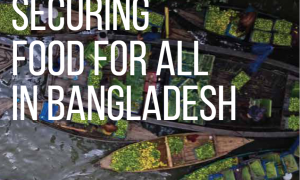Food is the most important basic need for sustenance and survival, and the right to food is among the fundamental human rights.
Search
Securing Food for All in Bangladesh presents an array of research that collectively addresses four broad issues: (1) agricultural technology adoption; (2) input use and agricultural productivity; (3) food security and output markets; and (4) pover
Technology is the basis for sustainable agricultural growth. Enhanced agricultural productivity and growth depend, to a large extent, upon the widespread adoption of appropriate technologies by farmers.
In Bangladesh, the dry season of October to March is characterised by falling water tables, reduction in the discharge of major rivers, drying water channels, and salinity intrusion, particularly in the southwest coastal region.
Despite declining arable agricultural land, Bangladesh has made substantial progress in boosting domestic food production, improving access to food by increasing household income, and enhancing nutritional outcomes
Agricultural production in Bangladesh has undergone dramatic changes over the past several decades.
This is the third round of the Bangladesh Integrated Household Survey (BIHS).
The Feed the Future Phase One Zone of Influence (ZOI) Endline Survey was implemented by IFPRI through Bangladesh Integrated Household Survey (BIHS) 2018-2019.
The purpose of the US Global Food Security Strategy (GFSS) 2018/2019 baseline survey in Bangladesh is to provide the U.S.
The expanded use of surface water for irrigation, intensified farm management, and double cropping have been highlighted by the Government of Bangladesh as policy priorities and development imperatives in the coastal region.
Cluster-based aquaculture growth
As shown in Chapter 3, fish production appears to be largely clustered and the number of fish farmers, feed traders, and fish traders have all experienced rapid growth since 2008, roughly in the same magnitude.
Value chain transformation
The majority of literature on aquaculture in Bangladesh focuses on “microsocioeconomics” and “value chains” (VCs) and tends to have a static perspective.
Summary and implications
Led by aquaculture, the fishery sector in Bangladesh has been remarkably successful in rapidly increasing production, reducing prices, and meeting rising domestic demand.
A rapid increase in aquaculture production in Bangladesh has lowered fish prices, increased protein consumption, and reduced poverty.
Sector overview and study design
The fisheries sector in Bangladesh is important in terms of both economic and food security perspectives.
Future scenarios (projections to 2050)
The Bangladesh fish sector has experienced both rapid growth and rapid change over the past several decades. With plentiful waterways, access to the sea, and a subtropical climate, prospects for future production growth are equally bright.
Aquaculture is one of the world’s fastest growing food-producing sectors, and its share in global fish consumption by humans is projected to grow to more than 60 percent by 2030 (FAO 2014).
In the last half of the 20th century, food policy in most Asian countries meant ensuring availability of cereals, mainly rice and wheat.1 The rationale for this cereal-centric policy is well understood.
The making of a blue revolution in Bangladesh: Enablers, impacts, and the path ahead for aquaculture
A rapid increase in aquaculture production in Bangladesh has lowered fish prices, increased protein consumption, and reduced poverty.

